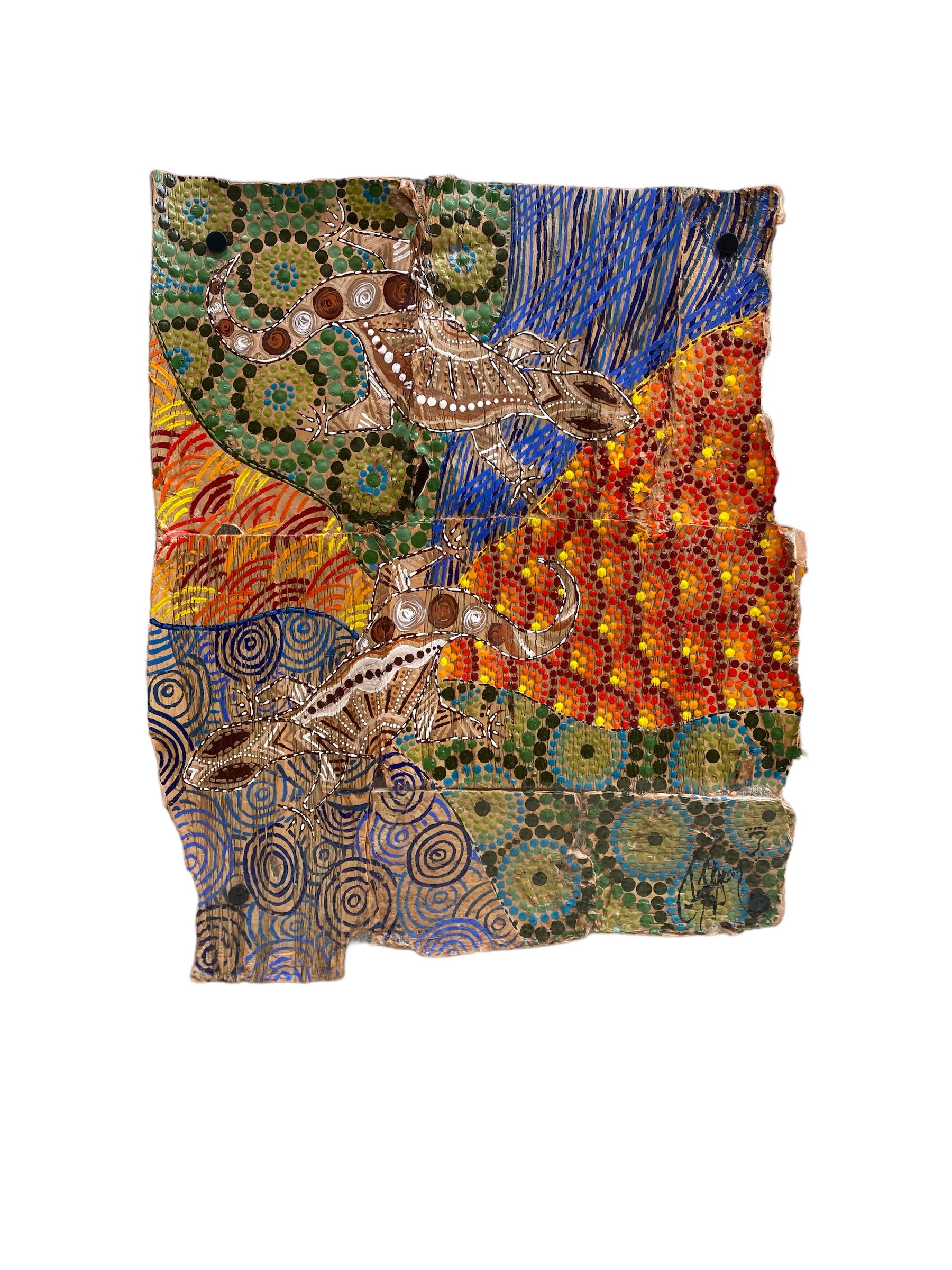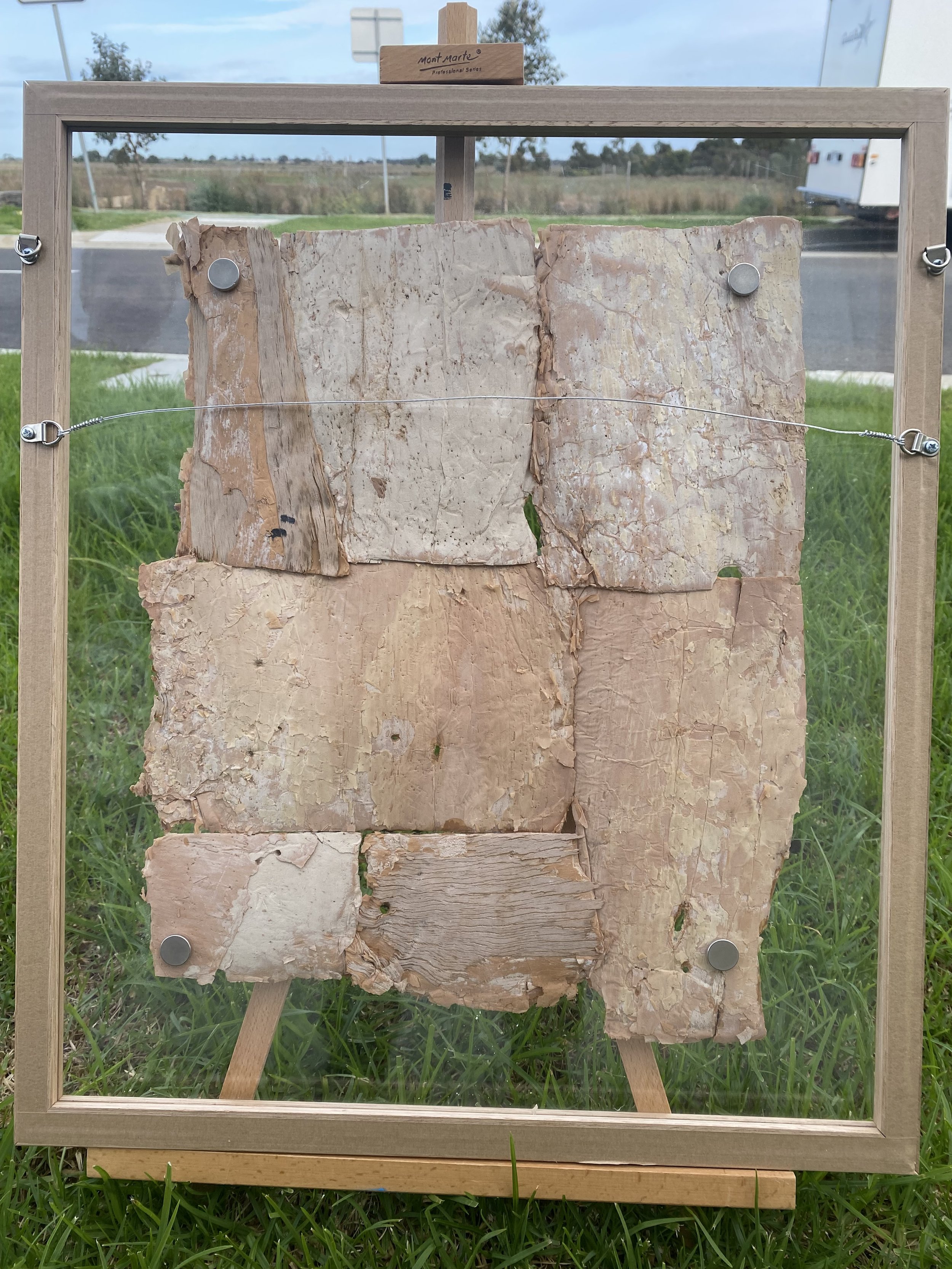 Image 1 of 3
Image 1 of 3

 Image 2 of 3
Image 2 of 3

 Image 3 of 3
Image 3 of 3




Tree Goanna’s
Paperbark painting is an Australian Aboriginal art form, involving painting on the interior of a strip of tree bark.
Bark for Indigenous Australian bark painting is cut from the trunk of the stringybark tree (Eucalyptus tetradonta) during the wet season. At this time the high moisture content within the bark facilitates its removal.
The rough, outer bark is stripped off and the thinned inner bark dried and flattened by placing the bark onto a fire, to cure and reduce moisture content. Later the surfaces are scraped and flattened with weights, and in some cases restraining sticks are attached at each end of the painting.
Pigments are traditionally ground on a stone and the powder mixed with water and a binding medium, such as orchid juice, beeswax, fats, egg yolk, tree and plant gums or resins.
Each Artwork comes with a framed certificate of authenticity that consists of the artwork story
Caring for a double-sided framed paperbark painting requires special attention to ensure its longevity and preservation.
Handle with Care: When handling the framed painting, hold it by the frame rather than the paperbark itself to prevent damage. Avoid touching the painted surfaces with your fingers, as oils and dirt from your hands can transfer and affect the artwork.
Protect from Moisture: Paperbark is sensitive to moisture and can warp or deteriorate if exposed to high humidity or damp conditions. Keep the painting in a dry environment and avoid hanging it in areas prone to moisture, such as bathrooms or kitchens.
Avoid Direct Sunlight: Direct sunlight can cause the colors in the painting to fade over time and may also affect the integrity of the paperbark. Display the painting away from windows or use UV-filtering glass to protect it from harmful UV rays.
Dust Regularly: Dust the surface of the painting regularly using a soft, dry brush or a microfiber cloth. Gently brush the surface to remove any dust or particles that may have accumulated. Be cautious not to apply too much pressure, especially on the delicate paperbark.
Rotate Display: To ensure even exposure to light and minimize potential damage from sunlight, periodically rotate the painting's display position. This can help prevent fading and uneven aging of the artwork.
Avoid Extreme Temperatures: Paperbark can be sensitive to extreme temperatures and fluctuations in temperature. Avoid hanging the painting in areas with excessive heat or cold, such as near heaters, air conditioners, or drafts.
Transport with Care: When transporting the framed painting, handle it with care to prevent damage to the fragile paperbark and the frame. Use padding or protective materials to secure the painting and prevent it from shifting during transit.
Store Properly: If you need to store the painting for an extended period, ensure it is stored vertically in a clean, dry, and well-ventilated area away from direct sunlight and moisture. Consider using acid-free tissue paper or archival materials to protect the artwork.
Professional Restoration: If the paperbark painting becomes damaged or shows signs of deterioration, consult a professional conservator or restorer with experience in working with paper-based artworks for advice on proper restoration and conservation techniques.
Paperbark painting is an Australian Aboriginal art form, involving painting on the interior of a strip of tree bark.
Bark for Indigenous Australian bark painting is cut from the trunk of the stringybark tree (Eucalyptus tetradonta) during the wet season. At this time the high moisture content within the bark facilitates its removal.
The rough, outer bark is stripped off and the thinned inner bark dried and flattened by placing the bark onto a fire, to cure and reduce moisture content. Later the surfaces are scraped and flattened with weights, and in some cases restraining sticks are attached at each end of the painting.
Pigments are traditionally ground on a stone and the powder mixed with water and a binding medium, such as orchid juice, beeswax, fats, egg yolk, tree and plant gums or resins.
Each Artwork comes with a framed certificate of authenticity that consists of the artwork story
Caring for a double-sided framed paperbark painting requires special attention to ensure its longevity and preservation.
Handle with Care: When handling the framed painting, hold it by the frame rather than the paperbark itself to prevent damage. Avoid touching the painted surfaces with your fingers, as oils and dirt from your hands can transfer and affect the artwork.
Protect from Moisture: Paperbark is sensitive to moisture and can warp or deteriorate if exposed to high humidity or damp conditions. Keep the painting in a dry environment and avoid hanging it in areas prone to moisture, such as bathrooms or kitchens.
Avoid Direct Sunlight: Direct sunlight can cause the colors in the painting to fade over time and may also affect the integrity of the paperbark. Display the painting away from windows or use UV-filtering glass to protect it from harmful UV rays.
Dust Regularly: Dust the surface of the painting regularly using a soft, dry brush or a microfiber cloth. Gently brush the surface to remove any dust or particles that may have accumulated. Be cautious not to apply too much pressure, especially on the delicate paperbark.
Rotate Display: To ensure even exposure to light and minimize potential damage from sunlight, periodically rotate the painting's display position. This can help prevent fading and uneven aging of the artwork.
Avoid Extreme Temperatures: Paperbark can be sensitive to extreme temperatures and fluctuations in temperature. Avoid hanging the painting in areas with excessive heat or cold, such as near heaters, air conditioners, or drafts.
Transport with Care: When transporting the framed painting, handle it with care to prevent damage to the fragile paperbark and the frame. Use padding or protective materials to secure the painting and prevent it from shifting during transit.
Store Properly: If you need to store the painting for an extended period, ensure it is stored vertically in a clean, dry, and well-ventilated area away from direct sunlight and moisture. Consider using acid-free tissue paper or archival materials to protect the artwork.
Professional Restoration: If the paperbark painting becomes damaged or shows signs of deterioration, consult a professional conservator or restorer with experience in working with paper-based artworks for advice on proper restoration and conservation techniques.
Paperbark painting is an Australian Aboriginal art form, involving painting on the interior of a strip of tree bark.
Bark for Indigenous Australian bark painting is cut from the trunk of the stringybark tree (Eucalyptus tetradonta) during the wet season. At this time the high moisture content within the bark facilitates its removal.
The rough, outer bark is stripped off and the thinned inner bark dried and flattened by placing the bark onto a fire, to cure and reduce moisture content. Later the surfaces are scraped and flattened with weights, and in some cases restraining sticks are attached at each end of the painting.
Pigments are traditionally ground on a stone and the powder mixed with water and a binding medium, such as orchid juice, beeswax, fats, egg yolk, tree and plant gums or resins.
Each Artwork comes with a framed certificate of authenticity that consists of the artwork story
Caring for a double-sided framed paperbark painting requires special attention to ensure its longevity and preservation.
Handle with Care: When handling the framed painting, hold it by the frame rather than the paperbark itself to prevent damage. Avoid touching the painted surfaces with your fingers, as oils and dirt from your hands can transfer and affect the artwork.
Protect from Moisture: Paperbark is sensitive to moisture and can warp or deteriorate if exposed to high humidity or damp conditions. Keep the painting in a dry environment and avoid hanging it in areas prone to moisture, such as bathrooms or kitchens.
Avoid Direct Sunlight: Direct sunlight can cause the colors in the painting to fade over time and may also affect the integrity of the paperbark. Display the painting away from windows or use UV-filtering glass to protect it from harmful UV rays.
Dust Regularly: Dust the surface of the painting regularly using a soft, dry brush or a microfiber cloth. Gently brush the surface to remove any dust or particles that may have accumulated. Be cautious not to apply too much pressure, especially on the delicate paperbark.
Rotate Display: To ensure even exposure to light and minimize potential damage from sunlight, periodically rotate the painting's display position. This can help prevent fading and uneven aging of the artwork.
Avoid Extreme Temperatures: Paperbark can be sensitive to extreme temperatures and fluctuations in temperature. Avoid hanging the painting in areas with excessive heat or cold, such as near heaters, air conditioners, or drafts.
Transport with Care: When transporting the framed painting, handle it with care to prevent damage to the fragile paperbark and the frame. Use padding or protective materials to secure the painting and prevent it from shifting during transit.
Store Properly: If you need to store the painting for an extended period, ensure it is stored vertically in a clean, dry, and well-ventilated area away from direct sunlight and moisture. Consider using acid-free tissue paper or archival materials to protect the artwork.
Professional Restoration: If the paperbark painting becomes damaged or shows signs of deterioration, consult a professional conservator or restorer with experience in working with paper-based artworks for advice on proper restoration and conservation techniques.
This beautiful piece is painted on paperbark with professional series acrylic paint and varnish. This unique and fragile piece of artwork has been professionally framed; double sided Perspex and floating with magnets in wooden frame. The wooden frame has hanging rings and wire attachments. I have kept the framed wrapped at all times for its protection.
Dimensions with frame: H 60.5cm L 52cm W 3cm
All Artworks that are purchased will be delivered via Courier.
Please select courier option. Once you check-out we will email you with an invoice.
This is to ensure safe and secure delivery.
